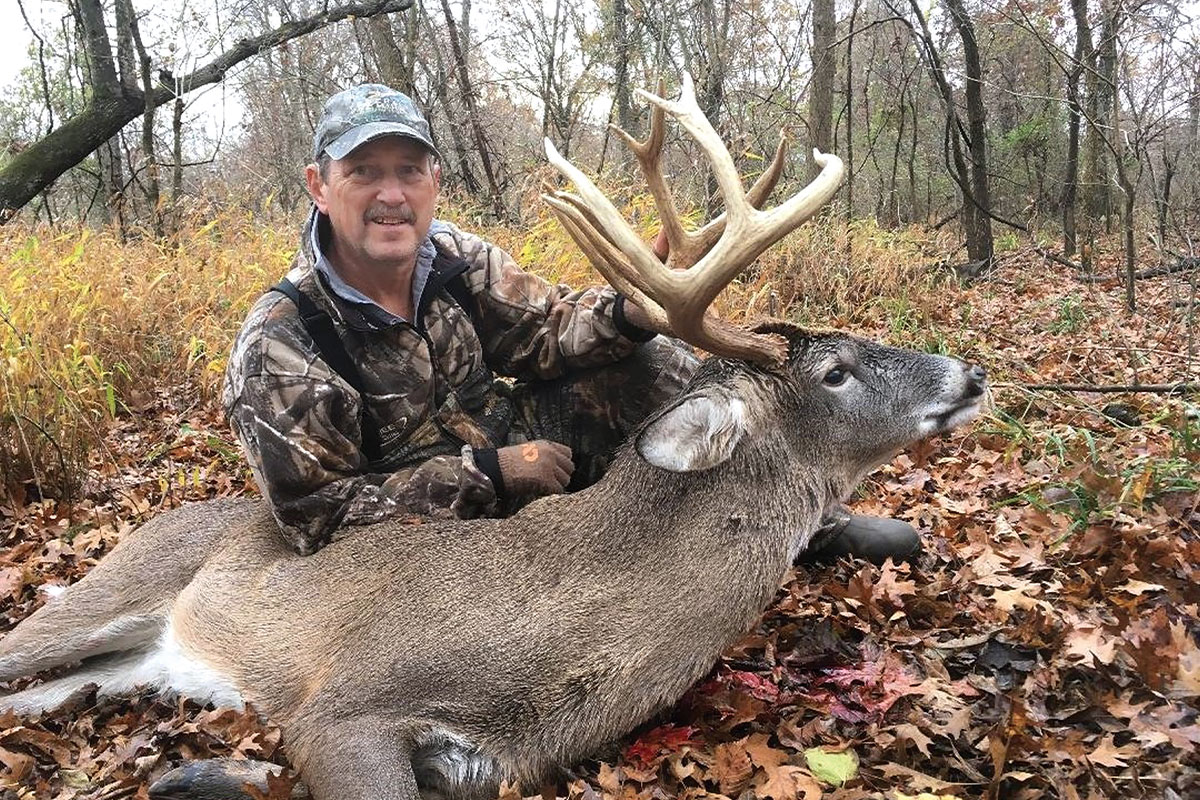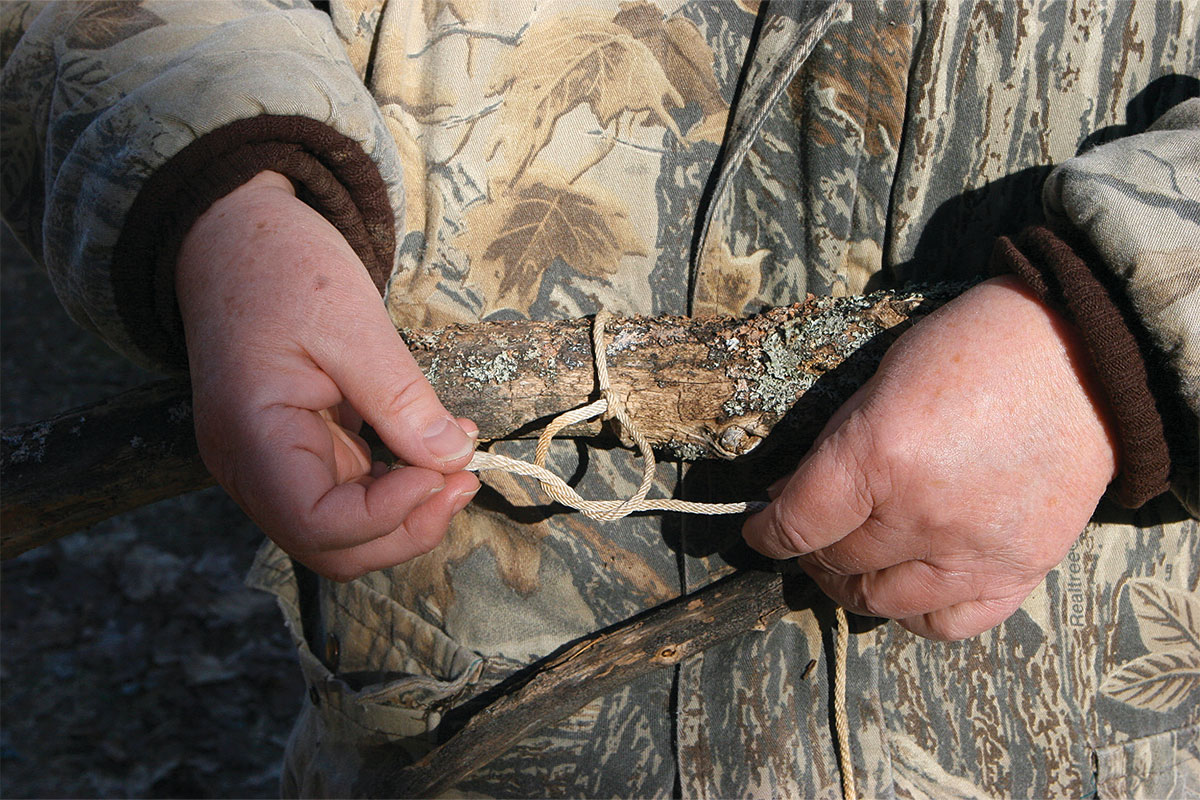
Veteran whitetail hunter Phil Henry, from Kingsport, Tennessee, has used a stick tied to a string to help him bag trophy bucks in numerous states; and you can do the same by using this tactic he pioneered. To be clear, he uses a stick on a string to call deer into position for a shot. Phil ties a stick on the end of the pull rope he uses to raise and lower gear to and from his tree stands to imitate the sound of a deer walking through the leaves.
“How many times have you grunted to a buck, had them stop to look and listen, and when they didn’t hear or see anything to confirm another deer was there, they went on?” Phil asks, when explaining the rationale behind his innovative technique. Those of you who routinely use a grunt call know that this happens frequently. “Now when I get a buck’s attention, I reach for my pull-up rope to move the stick that’s on the end of it and move it. So, it sounds like a deer walking or trotting in the leaves. That creates the illusion that there’s a buck where he heard the grunts and increases the chances a buck will come to investigate,” Phil says.
A 10-pointer that Phil shot with a muzzleloader in the mountains of Virginia is a perfect example. He was hunting from a tree stand that was on the crest of a ridge. “When hunting the mountains, I’ve gotten in the habit of grunting and working the stick on the string every 10 to 15 minutes,” Phil explains. “I did a sequence of grunting and working the stick at about 1:00 p.m., and I heard something. I looked around and saw a tree 70 to 80 yards away that was moving and shaking. A buck was tearing that tree up. When he looked my way, I could see he had a nice rack, but I couldn’t get a shot because too many branches were in the way.
“He goes back to working the tree over and then looks again. I worked the stick in the leaves and grunted at him. I always have a grunt tube on my left arm. When he heard that he bristled up, and then he circled downhill through some thick stuff. I thought he was gone. “I kept working the stick and grunting. Then I saw him coming back up to me. He came into the wind and was looking for the buck he thought was there. I finally shot him at 30 yards when he moved into an opening. It was 20 to 25 minutes from the time I first saw the buck until I shot him. If I had just been using a grunt call, I don’t think I would have gotten that buck.”
Any grunt call that sounds realistic will work, but Phil favors Primos calls, either the buck roar or rubber neck models. Any type of stick that is round and straight will work to create the illusion of a deer in the leaves when worked on a haul rope, but Phil said he prefers a stick that’s about two inches in circumference and about two feet long. Phil added that he’s used forked sticks and sticks with leaves on them, too. They worked just fine.
Unless you look for and select a stick ahead of time, you will have to settle for what’s available on the ground near your stand. Once you’ve found a suitable stick, you can leave it at the base of your tree for use on future hunts.
PERFORMING THE CALL
Most hunters might have the tendency to tie their pull-up rope around the center of a stick, but for the best results, Phil ties the stick to the string off-center. A stick fastened in that manner imitates the sounds of a deer moving through the leaves better. One end of the stick hits the leaves before the other, creating the illusion that a deer is walking.

It’s important to make sure your pull-up rope is long enough to reach the ground from a tree stand, of course. Also, you need to make sure that there’s leaves at the base of the tree to work the stick in. Phil says he puts the end of the string in the stand where it’s handy, so he can manipulate the string whenever he wants to. “A lot of hunters clear leaves away from the base of trees they hunt from,” Phil says. “I try to make sure there are plenty of leaves around the base of my trees that I can work a stick in.”
Phil doesn’t just use the stick on a string trick on big-antlered bucks. He also tries to lure small bucks and does close to his stands. “I’ve noticed that deer tend to follow one another through the woods,” Phil explains. “When a buck comes across the scent of another deer, they usually follow it, even if it’s another buck. If I bring a small buck close to my stand. “With the stick on a string, the next deer that comes along is likely to follow the scent of the previous deer,” says Phil. “In Virginia, I saw 17 bucks in the mountains by doing this where normally you only see a couple of bucks in a week.”

The experienced deer hunter confirmed the value of combining the use of a stick on a string with a grunt tube when experimenting on a little buck that had 4- or 5-point antlers. After seeing the deer, Phil grunted and the young buck stopped, looked around and listened. When it didn’t hear or see anything else, it continued the way it was going. When he grunted a second time, he got the same reaction. After the young buck started to walk off the second time, Phil put the stick into action and that was enough to increase the buck’s curiosity. By continuing to grunt and manipulate the stick on a string, he got that buck to come right under his stand and it looked over a bank, still trying to find the deer that it thought was there.
“Big bucks have heard hundreds of grunts,” Phil claims. “They will stop and listen and then walk off. If he hears what he thinks is another buck in the leaves, he knows exactly where he’s at. Now he’s thinking: I heard you grunt, and I’ve heard you in the leaves; now I’m going to come find you.”
REAL WORLD SUCCESSES
Phil said that if a deer is close, he might simply move the stick in the leaves. If a deer is far off, he often pulls the stick up off the ground and lets it fall. He added that using the stick on a string trick works best during the rut. “I’ve been doing this for the last three years and have been pulling in a bunch of deer by doing so,” Phil says. “Anybody else can do the same thing. It’s simple, easy to do and you don’t have to buy anything. Everybody’s got a pull-up rope, and there are plenty of sticks laying around in the woods.”
Phil killed the 10-point in Virginia that was mentioned earlier in 2018. In 2019, he killed beautiful bucks in Indiana and Virginia, both of which came in after doing a calling sequence, including working the stick on a string. He said both of those bucks came in looking for the buck they thought they heard. The buck from Indiana was a 10-point. The Virginia buck from 2019 was a long-tined 6-point that scored almost 130.
“I had been getting pictures of that 6-pointer for three years, and he was always a 6-point,” Phil says. “I knew I would shoot him if I ever got an opportunity. I shot this deer during muzzleloader season.” After the smoke cleared from shooting the big six, Phil reloaded and used his binoculars to look for the downed deer. Then he spotted a 2 1/2-year-old 8-point over 100 yards away. “I couldn’t resist playing with this deer, so I tried the stick on a string. He immediately looked up the hill in my direction and got alert. After a pause, he turned and walked within 30 yards of my tree looking over the curve of the hill for the buck he heard. While stopped, he scanned the area over the hill and then walked in the direction that he thought the sound came from.”
During the 2020 season, Phil bagged a big 10-pointer with a crossbow in Kansas that scored 159 6/8. The morning he got that buck at 8:00 a.m. was an exceptional one. Amazingly, he saw 13 other bucks before the one he shot came by. “I had seen eight different 8-points, two different 9-points, a 3-point and two spikes before shooting that 10-pointer. I had been using grunting and the stick on a string during all this activity. I used doe in heat scent also, and a couple of bucks came directly into the wind and stuck their noses on the scent bombs. It was just one of those mornings when everything was crazy!” says Phil.
PERFECTING THE ILLUSION
Although Phil generally uses a grunt call in conjunction with a stick on a string, he says the stick on a string can be combined with other types of calling, too. These include doe bleats, rattling and baiting, where legal, to help get shots at more bucks. “I joke that I’m trying to be as good as David Copperfield,” Phil says. “I try to create an illusion that there’s a live deer under my stand right now, and the deer that hear it have to come and check it out. It doesn’t work every time, but I am confident I can guarantee you that it will improve your odds of pulling-in a buck that hangs up out of bow range.
“Stand location is critical,” says Phil. “Stands should be placed so that deer cannot see past your stand. That prevents them from seeing there are no deer there, making it necessary for them to come closer to see the deer they think they are hearing. Deer are not stupid. If they can see all the way around the tree you are in, and they don’t see another deer to go with the sounds you made, they will leave.
“Put your stand close to heavy cover or some kind of thick edge where deer will hear everything you do. When they hear a grunt, a doe bleat and they hear deer in the leaves via stick on a string, presto! You have the illusion that deer are under your stand or very close. David Copperfield would be proud!”






![Air gun 101: The differences between .177 & .22 – Which jobs they do best ? [Infographic]](https://airgunmaniac.com/wp-content/uploads/2020/09/g44-218x150.jpg)





































![Air gun 101: The differences between .177 & .22 – Which jobs they do best ? [Infographic]](https://airgunmaniac.com/wp-content/uploads/2020/09/g44-150x150.jpg)


